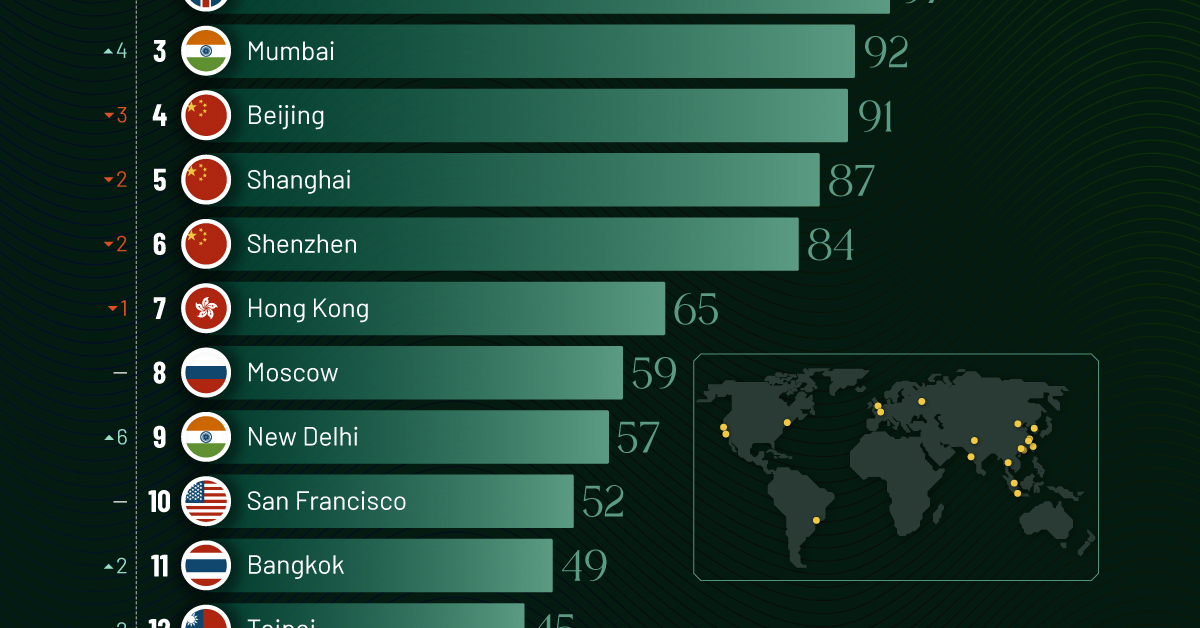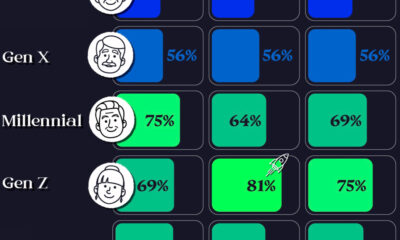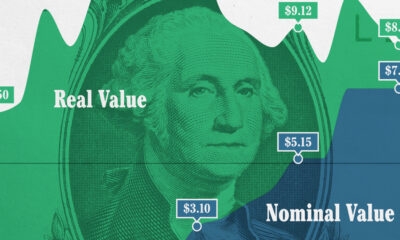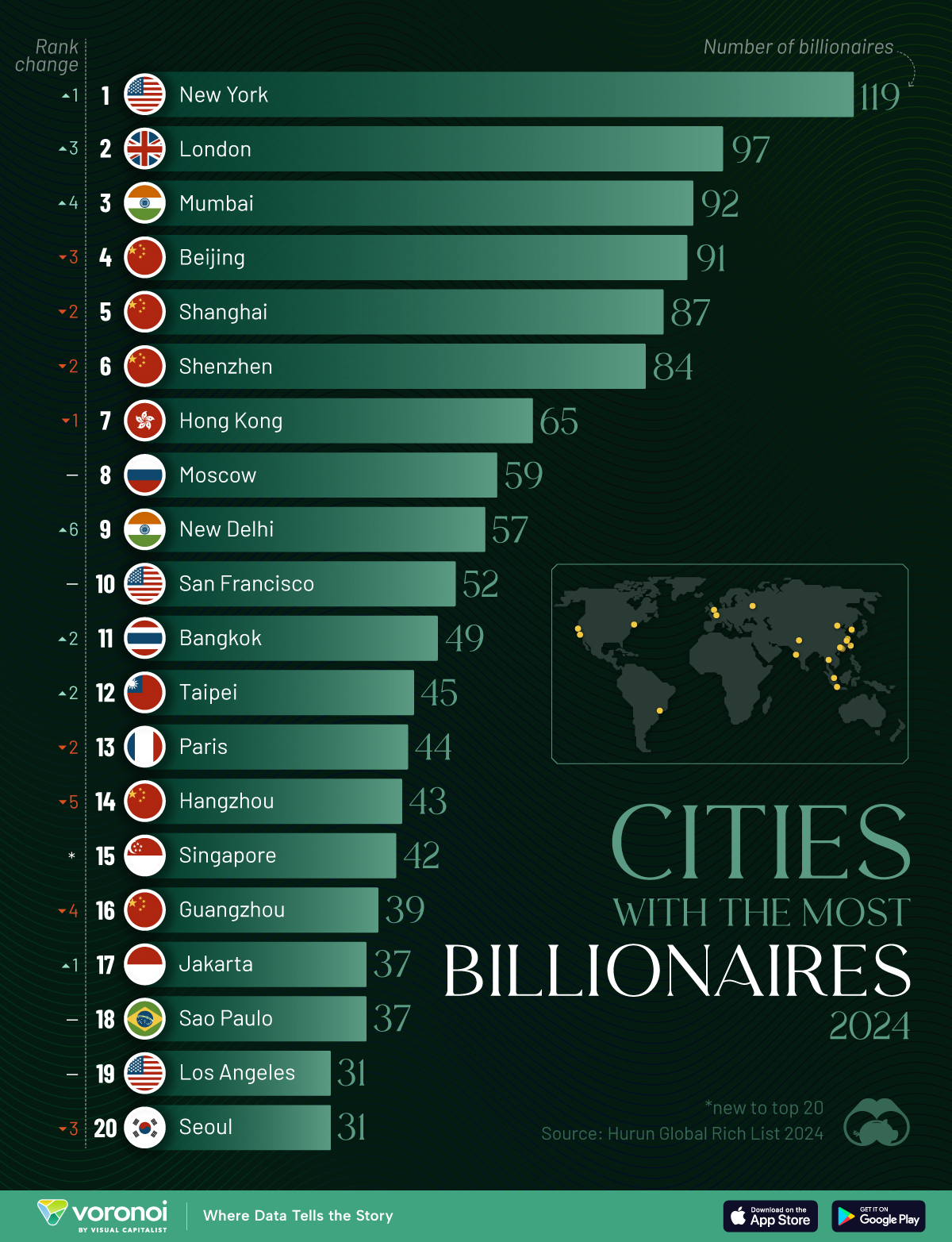Money
Why Gen Z is Approaching Money Differently Than Other Generations
Every generation has their own unique approach to money and personal finance.
Millennials, for example, found the journey to adulthood riddled with obstacles such as stagnating wage growth and uncertain economic conditions. These challenges, combined with other generational circumstances, helped to shape the group’s spending habits and attitudes towards money and debt.
Along this journey, Millennials ended up making their fair share of financial mistakes – but interestingly, evidence is now mounting that the next generational cohort (Gen Z) is already learning from their elders.
A New Approach to Money
Today’s infographic comes to us from Rave Reviews and it shows how Gen Z is taking a more pragmatic approach to money.

Gen Z saw some of their older friends take on massive amounts of debt, while also struggling to find well-paying jobs.
As a result, this new generation (born 1997 and onwards) is taking a much more pragmatic approach to the world of personal finance. Gen Zers generally want to secure well-paying and stable jobs, and to grow their savings rather than spending money that they don’t have.
School and Work
For Generation Z, an education is often seen as an end to a financial means. In other words, college is an opportunity to build a set of skills that will be valuable to employers, ensuring a stable career.
That’s why 88% of the first Gen Z grad class in 2017 ended up choosing their majors with job availability in mind.
Recent Gen Z grads are willing to put in the work, as well:
- 75% are willing to relocate to another state for a job offer
- 58% are willing to work evenings and weekends
- 78% have completed an internship or apprenticeship
- 77% earn extra money through freelance work, a part-time job, or an earned allowance
- 35% already own their own business, or are planning to start one in the future
While the Gen Z outlook on school and work is a defining factor in their attitude towards personal finance, how they save and spend money is also making a difference.
Saving and Spending
A whopping 89% of Gen Zers say planning for their financial future makes them feel empowered, while 64% have already begun researching the topic of financial planning.
With dollars and cents on their minds, Gen Z is a more frugal and fiscally responsible group:
- 72% say that cost is most important factor when making a purchase
- 47% use their phones in-store to check prices and ask family or friends for advice
- 66% plan to attend college in-state to save on tuition
As Gen Z enters the professional workforce and starts investing their savings, it will be interesting to see what comes out of this frugal and practical approach to money.
Money
Charted: Which City Has the Most Billionaires in 2024?
Just two countries account for half of the top 20 cities with the most billionaires. And the majority of the other half are found in Asia.

Charted: Which Country Has the Most Billionaires in 2024?
This was originally posted on our Voronoi app. Download the app for free on iOS or Android and discover incredible data-driven charts from a variety of trusted sources.
Some cities seem to attract the rich. Take New York City for example, which has 340,000 high-net-worth residents with investable assets of more than $1 million.
But there’s a vast difference between being a millionaire and a billionaire. So where do the richest of them all live?
Using data from the Hurun Global Rich List 2024, we rank the top 20 cities with the highest number of billionaires in 2024.
A caveat to these rich lists: sources often vary on figures and exact rankings. For example, in last year’s reports, Forbes had New York as the city with the most billionaires, while the Hurun Global Rich List placed Beijing at the top spot.
Ranked: Top 20 Cities with the Most Billionaires in 2024
The Chinese economy’s doldrums over the course of the past year have affected its ultra-wealthy residents in key cities.
Beijing, the city with the most billionaires in 2023, has not only ceded its spot to New York, but has dropped to #4, overtaken by London and Mumbai.
| Rank | City | Billionaires | Rank Change YoY |
|---|---|---|---|
| 1 | 🇺🇸 New York | 119 | +1 |
| 2 | 🇬🇧 London | 97 | +3 |
| 3 | 🇮🇳 Mumbai | 92 | +4 |
| 4 | 🇨🇳 Beijing | 91 | -3 |
| 5 | 🇨🇳 Shanghai | 87 | -2 |
| 6 | 🇨🇳 Shenzhen | 84 | -2 |
| 7 | 🇭🇰 Hong Kong | 65 | -1 |
| 8 | 🇷🇺 Moscow | 59 | No Change |
| 9 | 🇮🇳 New Delhi | 57 | +6 |
| 10 | 🇺🇸 San Francisco | 52 | No Change |
| 11 | 🇹🇭 Bangkok | 49 | +2 |
| 12 | 🇹🇼 Taipei | 45 | +2 |
| 13 | 🇫🇷 Paris | 44 | -2 |
| 14 | 🇨🇳 Hangzhou | 43 | -5 |
| 15 | 🇸🇬 Singapore | 42 | New to Top 20 |
| 16 | 🇨🇳 Guangzhou | 39 | -4 |
| 17T | 🇮🇩 Jakarta | 37 | +1 |
| 17T | 🇧🇷 Sao Paulo | 37 | No Change |
| 19T | 🇺🇸 Los Angeles | 31 | No Change |
| 19T | 🇰🇷 Seoul | 31 | -3 |
In fact all Chinese cities on the top 20 list have lost billionaires between 2023–24. Consequently, they’ve all lost ranking spots as well, with Hangzhou seeing the biggest slide (-5) in the top 20.
Where China lost, all other Asian cities—except Seoul—in the top 20 have gained ranks. Indian cities lead the way, with New Delhi (+6) and Mumbai (+3) having climbed the most.
At a country level, China and the U.S combine to make up half of the cities in the top 20. They are also home to about half of the world’s 3,200 billionaire population.
In other news of note: Hurun officially counts Taylor Swift as a billionaire, estimating her net worth at $1.2 billion.
-

 Education1 week ago
Education1 week agoHow Hard Is It to Get Into an Ivy League School?
-

 Technology2 weeks ago
Technology2 weeks agoRanked: Semiconductor Companies by Industry Revenue Share
-

 Markets2 weeks ago
Markets2 weeks agoRanked: The World’s Top Flight Routes, by Revenue
-

 Demographics2 weeks ago
Demographics2 weeks agoPopulation Projections: The World’s 6 Largest Countries in 2075
-

 Markets2 weeks ago
Markets2 weeks agoThe Top 10 States by Real GDP Growth in 2023
-

 Demographics2 weeks ago
Demographics2 weeks agoThe Smallest Gender Wage Gaps in OECD Countries
-

 Economy2 weeks ago
Economy2 weeks agoWhere U.S. Inflation Hit the Hardest in March 2024
-

 Green2 weeks ago
Green2 weeks agoTop Countries By Forest Growth Since 2001














